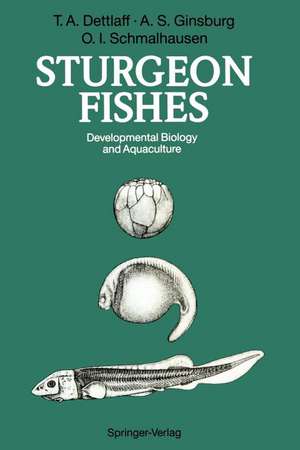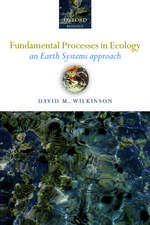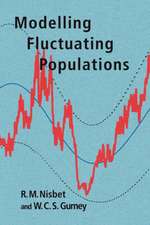Sturgeon Fishes: Developmental Biology and Aquaculture
Traducere de G. G. Gause Autor Tatiana A. Dettlaff Traducere de S. G. Vassetzky Autor Anna S. Ginsburg, Olga I. Schmalhausenen Limba Engleză Paperback – 18 ian 2012
Preț: 769.06 lei
Preț vechi: 937.88 lei
-18% Nou
Puncte Express: 1154
Preț estimativ în valută:
147.25€ • 153.33$ • 122.17£
147.25€ • 153.33$ • 122.17£
Carte tipărită la comandă
Livrare economică 14-28 februarie
Preluare comenzi: 021 569.72.76
Specificații
ISBN-13: 9783642770593
ISBN-10: 3642770592
Pagini: 320
Ilustrații: XIII, 300 p.
Dimensiuni: 155 x 235 x 17 mm
Greutate: 0.45 kg
Ediția:Softcover reprint of the original 1st ed. 1993
Editura: Springer Berlin, Heidelberg
Colecția Springer
Locul publicării:Berlin, Heidelberg, Germany
ISBN-10: 3642770592
Pagini: 320
Ilustrații: XIII, 300 p.
Dimensiuni: 155 x 235 x 17 mm
Greutate: 0.45 kg
Ediția:Softcover reprint of the original 1st ed. 1993
Editura: Springer Berlin, Heidelberg
Colecția Springer
Locul publicării:Berlin, Heidelberg, Germany
Public țintă
ResearchDescriere
This book is the first comprehensive description of development of the Acipenserid fish published in the English language. It con tains the results of more than 40 years of studies by the authors and their colleagues. My own life in science has been intimately related both with the authors and the fish, which are the subject of this book. Therefore, it gives me a great pleasure to present to the English reader an expanded version of the book. Those interested in the history of biology must be well aware of the fact that genetics in the USSR was practically demolished by Lysenko at the session of the Lenin All-Union Academy of Agricultural Sciences in 1948. However, it is much less well known that other fundamental branches of biology were also persecuted at that time, experimental embryology (developmental mechanics) among them. As a result, many embryologists, in cluding the authors of this book, were forced to turn to more ap plied problems, this being the only way to continue research. They had to abandon amphibians and concentrate their efforts on sturgeon.
Cuprins
1 Oocyte Maturation and Ovulation.- 1.1 Maturation of Sturgeon Oocytes in Nature and at the Hatcheries.- 1.2 Changes in the Oocytes During Their Maturation.- 1.2.1 Structure and Properties of the Fully Grown Oocyte.- 1.2.2 Changes in Oocytes During Their Maturation in Vivo.- 1.2.3 Chronology of Oocyte Maturation.- 1.2.4 Changes in Oocytes During in Vitro Maturation.- 1.2.5 Mechanisms of Oocyte Maturation.- 1.3 Ovulation of the Oocytes and the Formation of Coelomic Fluid.- 1.4 Hormonal Stimulation of Oocyte Maturation and Ovulation.- 1.5 Methods of Working with Sturgeon Spawners Migrating in Rivers at Different Seasons and Spawning During the Same or Following Year.- 1.5.1 Vernal Groups of Acipenserid Fish.- 1.5.2 Hiemal Groups of Acipenserid Fish.- 1.6 Introduction in Culture of Various Acipenserid Species.- 1.7 Influence of Environmental Conditions on the Capacity of Females to Respond to Pituitary Injection and the Hatchery Quality of Eggs.- 1.7.1 Influence of Unfavorable Temperatures and Keeping of Females at Spawning Temperatures on the Transition of Oocytes to Maturation Under the Influence of Hypophysical Gonadotropic Hormones.- 1.7.2 Influence of Unfavorable Temperatures on Oocyte Ovulation and the Quality of Eggs.- 1.8 Release of Eggs During Natural Spawning, Time of Oocyte Maturation and Ovulation and Time of Obtaining Eggs at Hatcheries.- 2 Embryonic Development.- 2.1 Gametes.- 2.1.1 The Egg.- 2.1.2 The Spermatozoon.- 2.2 Artificial Insemination of Eggs.- 2.3 Fertilization.- 2.3.1 Transformations of the Spermatozoon upon Its Encounter with the Egg (Acrosomal Reaction).- 2.3.2 Transformations of the Egg After Contact with the Fertilizing Spermatozoon.- 2.4 Cleavage and Blastulation.- 2.4.1 Morphology of Cleavage.- 2.4.2 Mitotic Cycle During the Period of Synchronous Cleavage Divisions and Its Dependence on Temperature.- 2.4.3 Desynchronization of the Division of Nuclei During Cleavage and Rearrangement of the Cell Cycle During Transition to Blastulation.- 2.4.4 Cleavage Defects.- 2.4.5 Percentage of Fertilization.- 2.5 Gastrulation.- 2.5.1 Reorganization of the Embryo During Gastrulation.- 2.5.2 The Fate Map by the Beginning of Gastrulation and the Dynamics of Morphogenetic Movements.- 2.5.3 Inductive Interactions During Gastrulation.- 2.5.4 Gastrulation Defects.- 2.6 Development of the Embryo from the End of Gastrulation to the Onset of Heart Beating.- 2.6.1 Neurulation.- 2.6.2 Development of the Embryo from the Closure of the Neural Folds to the Onset of Heart Beating.- 2.6.3 Developmental Defects.- 2.7 Development of the Embryo from the Onset of Heart Beating to the Time of Hatching.- 2.7.1 Morphology of the Embryo.- 2.7.2 Structure of Atypical Embryos at the End of Incubation.- 2.7.3 Duration of the Hatching Period and the Means by Which the Embryos are Liberated from Their Membranes.- 2.8 Duration and Rate of Embryogenesis in Various Acipenserid Species and Their Dependence on Temperature. Chronology of Development.- 2.8.1 Duration of Embryogenesis as Expressed in Astronomical Time Units.- 2.8.2 Relative Duration of Embryonic Periods.- 2.8.3 Method of Characterizing the Duration of Various Developmental Periods in Dimensionless Values.- 2.8.4 The Age of Embryos and Chronology of the Embryogenesis.- 3 Development of Prelarvae.- 3.1 Characteristics of the Prelarval Period of Development.- 3.2 Stages of Prelarval Development.- 3.3 Timing of Prelarval Development.- 3.4 Prelarval Development During the Period Between Hatching and up to the Beginning of Rhythmic Respiratory Movements.- 3.5 Development of Prelarvae from the Beginning of Rhythmic Respiratory Movements and up to Transition to Active Feeding.- 3.6 Differences Between Prelarvae of Different Sturgeon Species A. gueldenstaedti H. huso, A. stellatus, A. ruthenus, P. kaufmanni.- 3.7 Defects of Prelarval Development.- 4 Environmental Conditions of Spawning and Development.- 4.1 General.- 4.1.1 The Concept of Thresholds.- 4.1.2 Spawning Conditions.- 4.1.3 Relationships of the Developing Embryo with the Environment at Various Developmental Stages.- 4.2 Temperature Range.- 4.3 Oxygen Content of Water and Gas Metabolism in Embryos.- 4.4 Light Conditions.- 4.5 Quality of Water.- 4.6 The Range of the Ecological Optimum.- 5 Control of Incubation Conditions.- 5.1 General.- 5.2 Duration of Development as a Criterion for the Evaluation of Incubation Conditions.- 5.3 Normal Embryonic and Prelarval Development.- 5.4 Losses During Incubation, Their Magnitude and Sources.- Appendix A Quick Method for the Determination of Gonad Maturity in the Sturgeon (Kazanskii et al. 1978).- Appendix B Duration of Oocyte Maturation Time in Vitro as a Criterion for Selecting Sturgeon Spawners for Breeding (B.E Goncharov).- Appendix C Comparative Quantitative Determination of the Gonadotropic Activity in Sturgeon Pituitaries (Goncharov 1972).- Appendix D Relative Characteristic of Developmental Duration.- Appendix E Determination of Time for Injection of Pituitary Suspension and Inspection of Females After Pituitary Injection for Obtaining Eggs at the Optimal Time at Different Temperatures.- E.2 Determination of Time for Inspection of Females and Collecting Eggs.- E.3 Example for Calculation of the Maturation Time and Time of Female Inspection.- Appendix F Artificial Insemination of Sturgeon Eggs (Ginsburg 1963).- Appendix G Sampling for Determination of Fertilization Percentage, Extent of Losses, and Percentage of Abnormal Embryos.- Plates I–XX.- Abbreviations for Figures and Plates.- References.
















